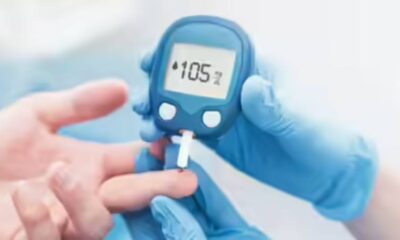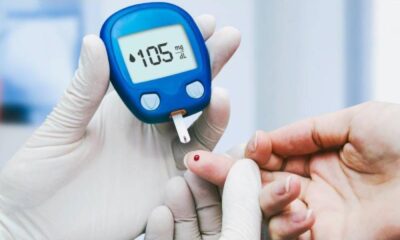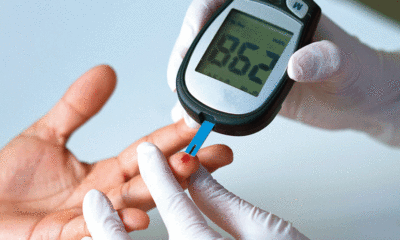Diabetology
High Blood Sugar in Children: Symptoms and Preventive Measures
Published
1 year agoon
By
Robert
Childhood is a time of boundless energy, growth, and exploration. However, amidst the laughter and play, a silent health concern can sometimes arise: high blood sugar. While less common than in adults, high blood sugar in children can have significant consequences if left unchecked. This article delves into the world of pediatric hyperglycemia, exploring its symptoms, potential causes, and most importantly, preventive measures.
We’ll begin by understanding the basics of blood sugar and its role in the body. Blood sugar, also known as glucose, is the primary fuel source for our cells. It comes from the food we eat, particularly carbohydrates, and is transported throughout the body by the hormone insulin. Insulin, produced by the pancreas, acts like a key, unlocking the doors of our cells and allowing glucose to enter for energy production.
However, when this delicate balance is disrupted, and the body either doesn’t produce enough insulin (type 1 diabetes) or becomes resistant to its effects (type 2 diabetes), blood sugar levels can rise above healthy ranges. This is what we call hyperglycemia.
The next section will explore the signs and symptoms of high blood sugar in children. By recognizing these early indicators, parents and caregivers can seek medical attention promptly and prevent complications.
Following the exploration of symptoms, we’ll delve into the potential causes of high blood sugar in children. While type 1 and type 2 diabetes are the most common culprits, other factors like certain medications, hormonal changes, and even some illnesses can contribute. Understanding the underlying cause is crucial for developing an effective management plan.
Symptoms of High Blood Sugar in Children
Unlike adults, children might not always express how they feel verbally. Therefore, it’s important for parents and caregivers to be vigilant and watch for the following signs of high blood sugar:
- Increased Thirst and Urination: One of the most common symptoms is excessive thirst and urination. The body tries to expel excess sugar through urine, leading to frequent bathroom trips. This, in turn, can make the child feel constantly thirsty.
- Fatigue and Lethargy: When cells are unable to access sufficient glucose for energy, the child may experience unexplained fatigue and lack of motivation. This can manifest as decreased activity levels, difficulty concentrating, and a general feeling of being “run down.”
- Increased Hunger: Even though there’s excess sugar in the bloodstream, the cells are starved for energy due to the lack of insulin’s action. This can lead to a paradoxical feeling of increased hunger, despite having recently eaten.
- Weight Loss: Although uncommon in type 2 diabetes, children with undiagnosed type 1 diabetes might experience weight loss. This happens because the body starts breaking down muscle and fat for energy when glucose isn’t readily available.
- Fruity-Smelling Breath: In severe cases of high blood sugar, the body might resort to burning fats for energy instead of glucose. This process, called ketosis, produces a distinctive fruity odor on the breath.
- Blurred Vision: High blood sugar levels can draw fluid from the lenses of the eyes, causing temporary blurring of vision. This symptom usually resolves once blood sugar control is achieved.
- Slow Healing Wounds: Chronically high blood sugar can impair the body’s natural healing processes. This can lead to delayed wound healing and an increased risk of infections.
- Frequent Infections: High blood sugar can weaken the immune system, making children more susceptible to recurrent infections like urinary tract infections (UTIs) and skin infections.
- Bedwetting: While bedwetting is more common in younger children, it can also be a sign of high blood sugar in older children who previously achieved nighttime dryness.
Causes of High Blood Sugar in Children
Several factors can contribute to high blood sugar in children. Here’s a breakdown of the most common causes:
- Type 1 Diabetes: This autoimmune disease occurs when the body’s immune system mistakenly attacks the insulin-producing cells in the pancreas. As a result, the body produces little to no insulin, leading to high blood sugar levels. Type 1 diabetes typically manifests in childhood or young adulthood and requires lifelong insulin therapy.
- Type 2 Diabetes: While traditionally considered an adult-onset condition, type 2 diabetes is becoming increasingly prevalent in children due to rising obesity rates and unhealthy lifestyles. In type 2 diabetes, the body either doesn’t produce enough insulin or becomes resistant to its effects. Unlike type 1, some children with type 2 diabetes might be able to manage their condition through lifestyle modifications like diet and exercise, while others may require medication.
- Certain Medications: Some medications, such as corticosteroids used for asthma or inflammatory conditions, can temporarily raise blood sugar levels. This is because corticosteroids can cause the liver to produce more glucose and can also decrease the body’s sensitivity to insulin. While these medications are crucial for managing certain conditions, it’s important to be aware of this potential side effect and monitor blood sugar closely, especially in children at risk for diabetes.
Other Causes of High Blood Sugar in Children
Beyond the primary causes mentioned above, several other factors can contribute to high blood sugar in children:
- Genetic Predisposition: Having a family history of diabetes increases a child’s risk of developing the condition. However, a family history doesn’t guarantee a diagnosis, and conversely, children with no family history can still develop diabetes.
- Polycystic Ovary Syndrome (PCOS) in Girls: PCOS is a hormonal disorder that can affect some girls during puberty. It can lead to insulin resistance and contribute to high blood sugar levels.
- Certain Medical Conditions: Some medical conditions, like cystic fibrosis and congenital malformations of the pancreas, can affect insulin production and lead to high blood sugar.
- Stress: Chronic stress can trigger the release of hormones like cortisol, which can temporarily increase blood sugar levels.
- Diet and Exercise: While not directly causing diabetes, unhealthy dietary habits and a lack of physical activity can contribute to weight gain and insulin resistance, increasing the risk of developing type 2 diabetes.
- Certain Infections: Severe infections can cause temporary spikes in blood sugar levels, even in children without diabetes.
Preventing High Blood Sugar in Children
The good news is that many cases of high blood sugar in children, particularly type 2 diabetes, can be prevented or delayed through healthy lifestyle choices. Here are some key strategies:
- Promote a Healthy Diet: Focus on a balanced diet rich in fruits, vegetables, whole grains, and lean protein. Limit sugary drinks, processed foods, and saturated fats.
- Encourage Physical Activity: Aim for at least 60 minutes of moderate-intensity physical activity most days of the week. This can include playtime, sports, or family walks.
- Maintain a Healthy Weight: Childhood obesity is a significant risk factor for type 2 diabetes. Encourage healthy eating habits and physical activity to help your child achieve and maintain a healthy weight.
- Regular Checkups: Schedule regular checkups with your child’s pediatrician. This allows for early detection of any potential problems, including high blood sugar.
- Vaccinations: Ensure your child stays up-to-date on vaccinations to help prevent infections that can contribute to raised blood sugar levels.
- Stress Management: Help your child develop healthy coping mechanisms to manage stress, such as relaxation techniques or spending time in nature.
- Open Communication: Talk openly with your child about healthy habits and the importance of blood sugar control. Encourage them to ask questions and express any concerns they might have.
Conclusion
High blood sugar in children can be a cause for concern, but it’s important to remember that with proper management and lifestyle modifications, children with diabetes can lead healthy and fulfilling lives. Early detection and intervention are crucial for preventing complications associated with chronic high blood sugar.
This article has provided an overview of high blood sugar in children, including its symptoms, causes, and most importantly, preventive measures. Remember, you’re not alone in this journey. Talk to your child’s pediatrician if you have any questions or concerns about your child’s blood sugar levels. They can provide personalized guidance and support to help your child stay healthy and active.
Disclaimer:
This information is intended for educational purposes only and should not be construed as medical advice. Always consult with a qualified healthcare professional regarding any questions or concerns you may have about your child’s health.
You may like
-


Daily Routine for Diabetics: A Complete Guide to a Healthy, Balanced Day
-


Morning Routine for Diabetics: Simple Steps to Stabilize Blood Sugar
-


Essential Lifestyle Tips for Preventing Diabetes Complications
-


Stress Management Emerging as Essential Part of Diabetes Care
-


Smart Strategies for Controlling Blood Sugar Naturally
-


Plant-Based Diet Linked to Blood Sugar Benefits, But Less Than Mediterranean Diet
The Latest News
- Daily Routine for Diabetics: A Complete Guide to a Healthy, Balanced Day
- Morning Routine for Diabetics: Simple Steps to Stabilize Blood Sugar
- Diabetes and Heart Disease Connection: Early Signs, Risks & Prevention
- Reversing Type 2 Diabetes: What the Latest Research Says in 2025
- Best Lifestyle Changes to Lower Stress and Balance Blood Sugar Naturally
- Best Morning Routine for Diabetics: A Complete Guide
- Diabetes Management: Effective Strategies to Control Blood Sugar Naturally

Daily Routine for Diabetics: A Complete Guide to a Healthy, Balanced Day

Morning Routine for Diabetics: Simple Steps to Stabilize Blood Sugar

Diabetes and Heart Disease Connection: Early Signs, Risks & Prevention

Lung growth invading Treg have different transcriptional profiles and capability connected to designated spot bar reaction

Psoriasis be treatment by adjuvant Salicylic acid, ceramides as this containing lotions

